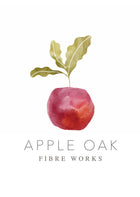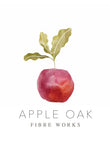



COCHINEAL DYE ~ Dye colours red, pinks to purples
Origin: Canary Islands, Spain. Organically farmed and processed by Canaturex
I am so delighted to have finally found some organic Cochineal. Lorenzo is one of the very first offering fully traceable Cochineal grown to organic principals.
Cochineal, a powerful dye sourced from tiny insects that feed on cacti, produces stunning shades of purple, red and pink. With just one dye bath, this incredible insect can create a range of hues, from deep, rich reds to delicate, fairy-like pinks. It is derived from the Dactylopius species of insects, and its body contains 19-22% carminic acid.
*To make one kilogram of cochineal dye, it takes about 80,000 to 100,000 insects.
Excellent colour fastness is guaranteed.
---------------------
Recipe for Wool Fibres: Downloadable PDF
Recipe For Plant Fibres: Downloadable PDF
Basic recipe:
6% Cochineal
Wool yarn mordanted with Alum 10%
Soak Cochineal in Water overnight
blend using a stick blender
Add dye to dye bath
Bring to a simmer
Remove any black tar like bubbles
Strain through a cloth and keep to the side
Add yarn to bath simmer for one hour.
Add dye bag to second and any following dye baths.
Organic Ground, Cut, or Whole Hibiscus Flowers
Vibrant Pink & Purple Hues for Dyeing | Cultivated in Egypt
Hibiscus flowers are an excellent choice for natural dyeing, offering stunning shades from light purples to deep pinks and even greens, depending on the mordant used. Ground Hibiscus produces a lighter purple hue on wool, while cut or whole flowers yield more vibrant tones. This pH-sensitive dye is perfect for hobby dyers and children’s activities, as it offers interesting colour shifts - from green to purple to pink - and an experimental approach to dyeing.
Dyeing Tips:
Colour Fastness: Poor (colour may shift with pH changes)
Basic Hibiscus Dye Recipe:
A delightful and experimental natural dye, perfect for adding beautiful, ever-changing shades to your projects!
Join The Natural Dyers & Growers Academy to share your experiences and get support from fellow growers.
RHUBARB ROOT GROUND ONLY
Dye Colour: Yellow Brown, Green (with Iron), Pink (with Soda Ash) – pH and Mordant Dependent | Country of Collection: China
Rhubarb root is a captivating natural dye, producing a spectrum of colours that vary depending on the pH of the dye bath and the mordant used. Known as a Quinone dye, it is rich in tannins, which yield earthy yellow-brown and green hues with iron. A higher pH will shift the colour to delicate pinks or reds, though these tones are less colourfast. Notably, the yellow and green shades are more stable, maintaining their colour for longer.
Colour Fastness:
pH Sensitivity: High pH will shift the colour to red.
Colour Outcomes by WOF Ratio & pH/Mordant:
Basic Recipe for Wool:
Instructions:
Explore the versatility of Rhubarb Root as a natural dye and unlock a range of rich, pH-dependent colours in your yarn and fabric projects!
RED SANDALWOOD DYE (Santalum species)
Dye Colour: Soft Pink and Red Tones | Country of Collection: Kongo, Africa
Red Sandalwood is a gentle, sustainable dye sourced from responsibly harvested forests in Kongo, Africa. It creates soft, rosewood-like pink and red hues that can be influenced by different mordants, allowing for subtle colour variations. While not a strong dye, it is perfect for creating delicate tones. Red Sandalwood is an economical choice as it can be used for several dips before exhaustion, and its natural fragrance enhances the dyeing process.
Colour Fastness: Medium
Colour Outcomes by WOF Ratio:
Basic Recipe for Dyeing:
Ingredients:
Instructions:
Notes:
Join The Natural Dyers & Growers Academy to share your experiences and get support from fellow growers.
We’re not fans of crowded inboxes either, so here’s what you can look forward to in our newsletters:
✨ Updates from the Academy – new workshops, courses, and events
🧶 News from the Dye House – behind-the-scenes, fibre stories, and inspiration
🛍 Shop highlights – fresh arrivals, special offers, and exclusive sales
And of course, you’re always in control — unsubscribe anytime with a single click at the bottom of any email.
As a little welcome gift, enjoy 5% off your first order in our webshop with the code WELCOMEPOP.
Happy making! 🌿




